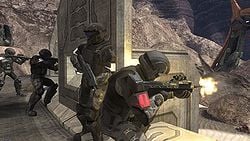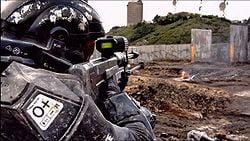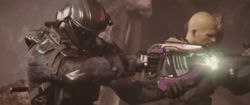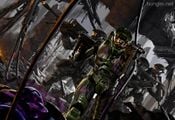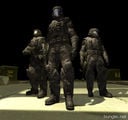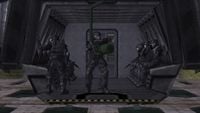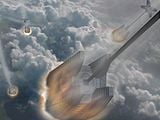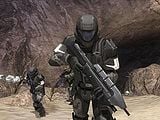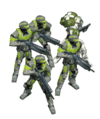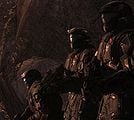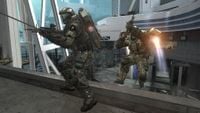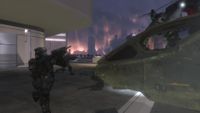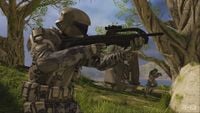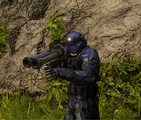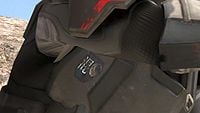Orbital Drop Shock Troopers: Difference between revisions
From Halopedia, the Halo wiki
AlertFiend (talk | contribs) No edit summary |
|||
| Line 164: | Line 164: | ||
{{Col-2}} | {{Col-2}} | ||
*''[[Halo: The Fall of Reach]]'' {{1st}} | *''[[Halo: The Fall of Reach]]'' {{1st}} | ||
*''[[Halo: The Flood]]'' | *''[[Halo: The Flood]]'' | ||
*''[[Halo: First Strike]]'' | *''[[Halo: First Strike]]'' | ||
Revision as of 12:24, January 8, 2016
| Orbital Drop Shock Troopers | |
|---|---|
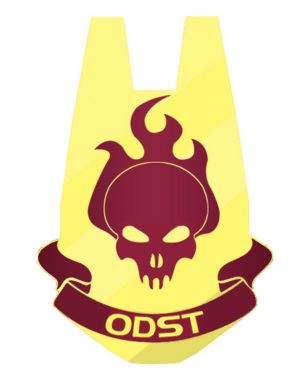
| |
|
Type: |
|
|
Affiliation: |
|
|
Operational authority: |
|
|
Branch: |
|
|
Size: |
|
|
Notable commanders: |
|
- Major Silva: "Most of the crew—not to mention your fellow jarheads—will be leaving the ship in lifeboats. They'll ride to the surface in air-conditioned comfort, sipping wine, and nibbling on appetizers. Not you, however. Oh no, you're going to leave the Pillar of Autumn in a different method. Tell me boys and girls... how will you leave?"
- Shock Troopers: "We go feet first, sir!"
- — Major Antonio Silva rousing his battalion aboard the Pillar of Autumn[4]
The Orbital Drop Shock Troopers (ODST)[note 1] are a special operations capable unit of the UNSC Marine Corps. One of the primary special operations forces of the United Nations Space Command, the ODST are under the administrative and operational control of Naval Special Weapons.[1][5] The organization is headquartered in the Martian city of Tanais, Kenosha.[2] Its primary training facilities were located on Reach prior to the glassing of the planet.[6]
Role
- "We had a damn hard job, and we did it better than anyone."
- — Spartan Edward Buck, referring to the ODSTs[7]
An elite unit of the UNSC Marine Corps,[8] Orbital Drop Shock Troopers are distinguished by their unconventional method of deployment, known as "transorbital support interdiction",[2] in which the troopers are dropped to the surface of a world aboard small, purpose-built deployment vehicles. This allows them to conduct a variety of missions against targets that more conventional forces cannot approach undetected.[1] ODSTs—trained for any kind of landing operation—expect to arrive at a world with hellish conditions, only to enter incredibly difficult combat zones.[8] ODST deployment via SOEIVs is often considered more effective than dropship deployment, as it allows for a spacecraft to make a quick pass over a world and deploy hundreds of ODSTs in SOEIVs in rapid succession. Additionally, since ODSTs are deployed separately, rather than together in one ship, the casualty rate of SOEIV deployment is lower than that of conventional dropship deployment.[9]
Each ODST combat team specializes in a particular mission set, though they are expected to be flexible enough to adapt to any given situation. ODSTs are known for their unusual methods of insertion, dropping from orbit onto terrestrial environments.[1] Often landing behind enemy lines, ODSTs are sometimes ordered to eliminate enemy units and clear a landing zone for the wave of troops that follow.[7] Similar to their infantry counterparts, the ODSTs maintain units of varying strength aboard many UNSC vessels and installations.[1] ODSTs may also serve as military police for UNSC installations.[10]
The ODST perform highly specialized, small scale, high-risk operations including:[5][1]
- Deep ground surveillance (DGS) and long range reconnaissance: Patrols in small groups, in uniform, usually far behind the enemy lines. While direct ground surveillance units may direct air or artillery strikes against enemy positions, they strive to be unobserved, and have only self-defense, not direct action, capability. Groups engaging in surveillance deep behind enemy lines, are commonly known as Long Range Reconnaissance Patrols.[1]
- Direct action (DA): Short-duration strikes and other small-scale offensive actions conducted as a special operation in hostile, denied, or politically sensitive environments and which employ specialized military capabilities to seize, destroy, capture, exploit, recover, or damage designated targets. Direct action differs from conventional offensive actions in the level of physical and political risk, operational techniques, and the degree of discriminate and precise use of force to achieve specific objectives.[1]
- Unconventional warfare: Military and paramilitary operations, normally of long duration, predominantly conducted by indigenous or surrogate forces who are organized, trained, equipped, supported, and directed in varying degrees by an external source. It includes guerrilla warfare and other direct offensive, low visibility, covert, or clandestine operations, as well as the indirect activities of subversion, sabotage, intelligence gathering, escape and evasion.[1]
- Counter-terrorism operations: The response to terrorist threats and/or acts, both real and imputed.[1]
- Counter-contraband operations: Missions undertaking the recapturing of smuggled/stolen goods.[1]
- Personnel and special equipment recovery/capture: The recovery/medical treatment of friendly personnel in combat environments, as well as the capability of capturing high valued individuals and any equipment.[1]
History
Origins and Interplanetary War
- Main article: Interplanetary War
The idea of inserting highly trained troops behind enemy lines from high altitudes has its roots in the paratroopers of 20th and 21st century fame, who dropped frequently behind enemy lines to capture strategically important targets in anticipation for a larger advance by more conventional and numerous military forces. Although they were only marginally successful, they proved the concept of paratroops as useful and effective in large-scale warfare.[2][11]
The United Nations created the first iterations of the ODST deployment concept in 2129;[2] these early incarnations were occasionally referred to as Drop Jet Platoons.[8] The Orbital Drop Shock Troopers in their current form saw their advent in 2163 with the formation of the UNSC Marine Corps and the UNSC itself from Earth's disparate national military forces.[2][12] That year also saw the first historic first extraterrestrial deployment of UNSC Marines in the Mars Campaign against the neo-communist Koslovics.[13]
The conclusion of the Interplanetary War in 2170, along with the signing of the Callisto Treaty and the subsequent years that followed, the ODST saw little action as more political, and more important issues such as overpopulation and famine and a massive military with no purpose gripped the postwar nations of Earth.[13]
Insurrection
- Main article: Insurrection
The first major combat re-emergence of the ODSTs occurred in 2490 during the beginnings of the civil conflict between the Unified Earth Government and the Insurrectionists. Using the members of the ORION Project as exemplary models,[14] the reputation of the ODST, as well as their training, was restored and enhanced as time passed. For the years leading up to 2525, the ODST conducted high-risk operations against the Insurrectionists, to either stop the enemy before they could carry out attacks against supporters, and officials of the Unified Earth Government or to cut off major suppliers to the Insurrectionists.[2]
The ODSTs' 10th Shock Troops Battalion was deployed to Jericho VII for over 131 days to put down local insurgent forces.[15] Shortly after, the unit was sent to Arcadia to deal with Insurrectionist activity.[16] In 2526, the battalion was deployed to Andesia to eliminate a Insurrectionist strongholds on the planet. During the deployment, several members of the unit were killed by insurgent forces.[17]
Human-Covenant War
- Main article: Human-Covenant War
On November 1, 2525, the UNSC moved into a full alert status after the devastating and horrifying first contact with the Covenant at Harvest; this marked a change in objectives for the ODST, who up until that point had been fighting the Insurrectionists.[18] As humanity's military turned to meet the threat of the Covenant, divisions of ODSTs prepared to participate in the most critical engagements in the war and also to conduct the riskiest missions in the history of mankind. In April of 2526, the Corbulo Academy of Military Science on Circinius IV came under attack by Covenant forces. ODSTs were deployed directly onto the campus to reinforce the already-present Marine garrison. But by the time SPARTAN-IIs John-117, Kelly-087, and Fred-104 arrived, the deployed ODSTs, along with the entire academy's staff, students (save for four survivors), and garrison were slaughtered.[17]
The Battle of Hat Yai marked one of the first deployments of ODSTs against Covenant ground forces; although the planet was lost in the ensuing conflict, the ODSTs were successfully extracted before the UNSC retreated.[19] Not long after the Harvest campaign, the ODST participated in the Battle of Arcadia, where they assisted Marine forces and SPARTAN-II Red Team in defending the capital city from Covenant ground forces, thus allowing the evacuation of the civilian population. Having successfully kept Covenant forces from occupying the city, the Corps began launching multiple assaults on the Covenant's bases of operations to reclaim the planet. Several ODST platoons joined the Spirit of Fire's rescue operation after retaking the planet and soon participated in Battle of Shield 0459.[20]

Following the enactment of the Cole Protocol in 2535, ODST combat teams were tasked with boarding commercial and private vessels and purging their navigation databases.[21] During one of these routine operations, a group of ODSTs aboard the UNSC Midsummer Night were captured and taken to the Rubble. They, in conjunction with SPARTAN-II Gray Team, would later defeat a Kig-Yar plan to trick the inhabitants of the Rubble out of their navigation data, which could compromise the location of Earth.[22] As the Human-Covenant War progressed, the ODST would participate in many engagements; among these were the Battle of Jericho VII,[23] an assassination mission on Heian,[24] the Battle of Skopje,[25] the Battle of Sigma Octanus IV, the Battle of New Jerusalem, the Battle of Tribute,[26] and the Battle of Ariel.[27] The numerous campaigns and operations in which the ODST participated throughout the long war all pale in comparison to the Fall of Reach in 2552, during which countless ODSTs lost their lives defending strategic locations on the planet.[28]
During the initial invasion of Reach, a large contingent of ODSTs participated in the Battle of Viery, assisting the Army in repelling the Covenant forces from the planet. Throughout the course of the battle, the UNSC formed joint-forces to combat against the overwhelming Covenant forces.[28] Some time during the event, several battalions were stationed on UNSC Pillar of Autumn. As the planet fell to the Covenant onslaught, the vessel made a blind slipspace jump away from the Epsilon Eridani system, discovering the long-abandoned Installation 04. During the Battle of Installation 04, shock troopers led by Major Antonio Silva and First Lieutenant Melissa McKay, operated as a guerrilla force by conducting hit-and-run operations against the forces of the Covenant's Fleet of Particular Justice.[29]
Endgame
| This section does not have enough inline citations and/or does not adhere to the proper citation format. You can help Halopedia by adding citations. |
Fresh from the disastrous loss of Reach, the ODST participated in the most significant battle of the entire war: the Battle of Earth.[30] The battle began on October 20, 2552, when a smaller-than-expected Covenant fleet led by the Prophet of Regret jumped into the Solar System. ODST combat teams, along with the Marines, began engaging Covenant forces on the Orbital Defense Platforms Cairo, Athens, and Malta. Despite the ODSTs' valiant efforts, Malta and Athens were destroyed. As the Covenant ship carrying the Prophet of Regret landed over the African mega-city of Mombasa, teams of ODSTs were deployed over the city from orbit in an attempt to board the carrier; before the teams could reach the target, however, the carrier jumped into Slipspace. Only a single squad managed to safely land in the city to carry out the retrieval of the Superintendent's data.
After Regret's unexpected retreat from New Mombasa, members of the 7th Shock Troops Battalion would later drop from the In Amber Clad onto Installation 05 during the operation to capture the Prophet of Regret. Most of these troopers would perish during the initial firefights against the Covenant, and only a few would escape back to Earth with Lieutenant Commander Miranda Keyes to lead a resistance against the Covenant occupation forces.[31]
Overall, the defense of Earth was one of the largest campaigns the ODST fought in during the entire war. The fighting spread across the globe and in space as the Fleet of Furious Redemption and the Prophet of Truth's own fleet attacked the remnants of the Orbital Defense Grid. The fleets soon deployed troops throughout the continents of North America, South America, Europe and Asia. The Battle of Cleveland is one example of the ODSTs' participation during the war on Earth. Two ODSTs from the 2nd Shock Troops Battalion fought alongside a detachment of Marines in the Battle of Pawas.[32] Troopers T. Rymann and S. Hartley were tasked with calculating the crash site of John-117 on Earth, while a Marine battalion was tasked with defending a narrow corridor between Covenant and UNSC forces in Pakistan. Bravo-21 and numerous Marines were killed in the clash, while Bravo-22 was injured along with some of the other surviving Marines. Their actions successfully allowed HIGHCOM to track and locate the Spartan.
After the opening of the Portal in November of 2552, the 11th Marine Force Reconnaissance/ODST, stationed aboard the UNSC Forward Unto Dawn, fought alongside SPARTAN John-117, during Operation: BLIND FAITH.[33] Men and women from this battalion were also some of the first humans to travel outside the Milky Way Galaxy, during the Battle of Installation 00.[34] One such assault happened during a mission to destroy numerous Covenant anti-aircraft artillery platforms overlooking a desert. These AA guns were destroyed by the ODSTs, allowing the UNSC Forward Unto Dawn to successfully land near the Cartographer building.[34] During the last battle of the Ark campaign—the last battle of the war—ODSTs were again airlifted into combat. This time, they punched holes in Covenant armor and artillery positions to allow SPARTAN-117 and the Arbiter to eliminate the Prophet of Truth. After the battle, the surviving ODSTs were taken back to Earth aboard the Sangheili flagship Shadow of Intent.[35]
Post-war
Many ODSTs joined the SPARTAN-IV program after the war ended, prompting the development of a MJOLNIR (GEN2) variant of the ODST BDU.[36] The ODSTs remain an active military unit, with the 3rd Helljumper Platoon participating in the Battle of Draetheus V against Merg Vol's Covenant faction in 2554.[37] In 2555, a small fireteam pulled from ODST squad Alpha-Nine participated in a mission at an unknown United Rebel Front facility on the moon Talitsa.[38] There was a battalion of ODSTs aboard the UNSC Infinity as of 2558.[39]
After 2552, the ODSTs held the Generation After Next upgrade competition for replacements to the venerable ODST armor. Acheron Security submitted the Void Dancer for consideration, though it was considered costly and temperamental, a risky investment in the UNSC's post-2552 "procurement wars".[40]
Organization
- Main article: [[:
- Category:Orbital Drop Shock Trooper units|List of Orbital Drop Shock Trooper units]]
Under the authority of the Naval Special Weapons (NAVSPECWEP) division, the Orbital Drop Shock Troopers are a special operations unit of the UNSC Marine Corps. Though ODST units are not embedded within conventional UNSC forces, they do participate in joint operations and tend to be force multipliers, increasing the effectiveness, willingness, and morale of those they fight alongside.[30] There is at least four divisions of Orbital Drop Shock Troopers,[3] with the 105th Shock Troops Division being the most notable.[8]
The number of ODST combat teams varies from company to company, but it generally consists of six to eight, with each combat team specializing in a particular mission-set. Every ODST combat team consists of anywhere between ten to fourteen members, each one having a specific skill or function on the team.[30] ODSTs are also organized into fireteams of six to eight personnel each.[2] Though every team and every individual is expected to particularly excel in their given skills and assigned mission-sets, they are expected to be flexible enough to adapt to any given situation.[30]
Personnel
- "Feet First into Hell."
- — The ODST motto[41]
A strictly volunteer force, the Orbital Drop Shock Troopers are recruited from special operations units in the UNSC Marine Corps, the Army, and the Navy; they are also drawn from the special operations groups of all UEG member nations' standing militaries.[1][42] The rigorous selection standards and a "mandatory" high level of bravery required to join the organization helps ensure that the ODSTs are one of humanity's most elite units,[8] only behind the SPARTAN programs.[2] See here for a list of personnel.
Potential ODSTs are selected because of their performance in their chosen Military Occupational Specialty; because every ODST candidate is a veteran from another special operations outfit they have already gone through at least two layers of screening and months of intense training—not counting the years of training received before volunteering for the ODST. There are no age or gender restrictions as long as the candidate meets the physical and mental requirements they are guaranteed the opportunity to try out for the ODST. Once in the ODST a candidate's training continues—its entrance requirements serve as a third layer of screening upon two more, where applicants would have theoretically failed to pass. Candidates would, therefore, already have extensive experience in conducting the types of high-risk missions that the ODSTs typically perform.[30]
Training
Orbital Drop Shock Troopers receive months of intense training, outside of the training they had originally received from their previous line of duty.[30] For three weeks, to get all personnel physically fit, ODST candidates may endure daily runs, push-ups, and numerous obstacle courses. These obstacle courses include training simulations with slush, artificial snow, and live gunfire-simulated battles. Candidates are trained to crawl for miles through environments with barbed wire, rubble, and destroyed buildings as drill instructors fired rounds inches over the heads of trainees.[43] Additionally, trainees practice jumping from high positions to prepare for transorbital drops.[44] The rigorous training process also serves as an opportunity for candidates—those that prove to be too relatively inept to become an ODST—to drop out of the program[43] or they are removed from the training by an instructor. These candidates are Returned to Unit (RTU), meaning that they are sent back to their previous unit and post.[45]
Following the three weeks of physical training, the next portion of ODST training is squad tactics, in which teamwork is a priority. In one example, remaining candidates are to don a full set of ODST training gear and are given weapons loaded with tactical training rounds, and are then dropped off at the base of a mountain. Candidates are then ordered to reach the peak of the mountain; the drill instructor accompanies them. Drill instructors may occasionally shoot trainees in the leg with a pistol loaded with TTRs, which essentially causes paralysis in the leg. Any candidates that are not quick enough to pick up speed are shot in the other leg, forcing them to crawl the rest of the way. This training simulation may be ran several times with added difficulties, such as trainers serving as opponents armed with TTR-loaded weapons. Some trainees would have to serve as distractions to give their peers the opportunity to eliminate their opponents.[43]
After squad tactics, ODST candidates are given tactical training. The trainees are assembled into fireteams and are then given the same challenges that they had experienced in the squad tactics training; the fireteams worked together individually to attempt to reach the peak of the mountain. After the fireteams were individually trained for a period of time, squad tactics is reintegrated back into the candidates' training. Two fireteams work together to reach the top of the mountain, with each fireteam providing support and suppression against opponents for the other.[43]
Psychology
Orbital Drop Shock Troopers are famous among those of the United Nations Space Command for their tenacity in combat.[46] The wide diversity of individuals that serve as ODSTs occasionally leads to cultural barriers; it was considered to be part of their "curious charm".[42] The dangerous method in which ODSTs are deployed often leads to the creation of an important distinguishing psychological characteristic commonly displayed among their ranks.[2] Orbital Drop Shock Troopers are very proud of their accomplishments and skills. Many ODSTs believe they uphold a "commando's state-of-mind", meaning that they can do anything with the right attitude.[47] Among their peers, ODSTs are often jovial and almost carefree. However, when an ODST is around an individual who is not a member of the organization, they often become stoic, overtly unfriendly, and have a complete absence of any expression, though they still often remain relaxed. Many individuals have confidence that the ODSTs can do nearly anything they are tasked to do, no matter the difficult of the assignment.[42] Being Returned to Unit (RTU)—not successfully completely ODST training—is considered highly humiliating, to the point that it makes death seem like a "minor embarrassment" in comparison.[45]
UNSC Insertion Protocols dictate that the commanding officer's SOEIV should accelerate after an ODST unit is deployed, thus placing it before the rest of the unit's drop pods. This is due to the strongly held belief—among the ODSTs—that officers should lead their troopers into battle, rather than follow. It is also held that officers should be willing to do anything they would ask their subordinates to do, and should expose themselves to the same level of danger as their troopers.[1][8] ODSTs occasionally gave tattoos of the kanji symbol for either "bastard" or "bad ass"—as the meaning differs depending on who is asked—to officers that they heavily respected. If the branded individual revealed their tattoo to any ODST, the ODST would allegedly aid the individual.[48]
Orbital Drop Shock Troopers—especially those from the 105th Shock Troops Division—have a somewhat rough relationship with members of the SPARTAN-II program. Due to the fierce pride found in many ODSTs and their inferiority compared to the elite Spartan supersoldiers, most Shock Troopers have some form of resentment toward the Spartan-IIs.[49] Former ODST Edward Buck remarked that he once considered the Spartan-IIs to be "glory-hungry bullet catchers".[7] This one-sided rivalry likely originated on April 22, 2525, when members of the 105th were involved in a fight with the fourteen-year-old Spartan John-117, resulting in three ODST deaths and one severe injury.[50]
Equipment
Battle dress uniform
- Main article: ODST armor
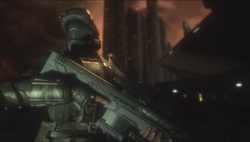
The ODST battle dress uniform is the signature piece of equipment used by the ODSTs—the armor is vacuum-rated and capable of extra-vehicular activity for fifteen minutes.[51] The helmet, a derivative of the standard-issue CH252 helmet, is equipped with modern communications gear, a heads-up display, and motion trackers.[8] The helmet is also issued with Visual Intelligence System, Reconnaissance, a proprietary integrated data management system that provides its users with navigational data, access to certain infrastructure systems, and allows them to store mission content.[1]
Manufactured by Misriah Armory,[52] the ODST armor incorporates titanium composites for armor plating to give the user added protection.[53] The armor includes a heating and cooling system that has the capabilities to match the infrared signature of the current local weather. There is several editions and variants of the armor with mission-specific functions.[8] By early 2553, the Generation After Next program was ran by the ODSTs to upgrade or replace the suit; Acheron Security's Void Dancer suite was an entrant in the competition.[54]
Human Entry Vehicle
- Main article: Single Occupant Exoatmospheric Insertion Vehicle
The Single Occupant Exoatmospheric Insertion Vehicle (SOEIV), or the Human Entry Vehicle, is a teardrop-shaped drop pod protected with a ceramic skin coating.[8] It is the signature piece of equipment used by the ODSTs and is known for its risks and intense heat which has garnered 105th ODST Division the nickname "Helljumpers". While most combat deployments are made by means of ordinary dropships, the SOEIV was designed as a more efficient method of orbital deployment for high-risk operations.[55] Often deployed from orbiting spacecraft or space stations, SOEIVs are equipped with its occupant's weapons, ammunition, and other supplies. Upon landing, each ODST is responsible for removing the supplies from their SOEIV and bringing it to their unit's temporary base.[1]
Trivia

|
Browse more images in this article's gallery page. |
- The ODST were heavily influenced by the Mobile Infantry from Robert A. Heinlein's seminal novel Starship Troopers, which popularized the use of drop pods in science fiction. The ODST's tradition of officers deploying before enlisted personnel is also inspired by the Mobile Infantry. In addition to drop pods, the science fiction tropes of powered armor (such as MJOLNIR) and hive-minded, insectoid aliens (including the Yanme'e) were also codified in the book. Furthermore, the NOVA bomb is named for a similar weapon from Starship Troopers.
- If an ODST is transformed into a Flood combat form in Halo 3 his armor will become that of a regular Marine. This is because no model for an ODST combat form exists in the game's files.
- During development of Halo 2, Eric Trautmann and Brannon Boren argued for the inclusion of ODSTs in the game, despite Bungie questioning their recognizability to fans and the in-universe role they served.[56]
Gallery
Concept art of ODSTs fighting alongside John-117 in New Mombasa
Concept art of an ODST facing an enraged Jiralhanae
An ODST wielding a BR55 Battle Rifle on Delta Halo in Halo 2
T. Rymann and S. Hartley at Sector Six in Pawa, Pakistan in Halo: Landfall
ODSTs dropping into a Covenant prison camp in Cleveland in Halo: Uprising
A team of ODSTs deployed on Installation 00 alongside John-117 in Halo 3
An ODST fireteam in Halo Wars
The Rookie in the streets of New Mombasa in Halo 3: ODST
Three ODSTs outside ONI Sword Base on Reach in Halo: Reach
A team of Bullfrogs during the Raid on New Alexandria
Two ODSTs get ready to board Gunnery Sergeant Buck's UH-144 Falcon in New Alexandria
The former ODST Sarah Palmer fighting several Sangheili on the cover of Halo: Initiation #1
A render of an ODST for Halo 2: Anniversary
ODSTs led by Marcus Stacker in Old Mombasa
An entire contingent of ODSTs deploy onto Installation 05 from the UNSC In Amber Clad in Halo 2: Anniversary
ODSTs and Sergeant Tanaka on Cleyell in 2556 in Halo: Escalation
ODSTs in Hunt the Truth.
List of appearances
Note
- ^ The plural form, when referring to the organization, is "ODST". However, individuals or small groups of troopers are addressed as "ODSTs".
Sources
- ^ a b c d e f g h i j k l m n o p q Bungie.net, ODST Field Guide
- ^ a b c d e f g h i j Halo Waypoint: ODST
- ^ a b Halo: First Strike, page 104 (2003); page 130 (2010)
- ^ Halo: The Flood, page 37 (2010)
- ^ a b Halo: The Essential Visual Guide, page 131
- ^ Bungie.net: CAA Factbook excerpt
- ^ a b c Halo: New Blood, pages 6-7 (Google Play edition)
- ^ a b c d e f g h i Halo Encyclopedia, pages 58-63 (2011)
- ^ Halo Waypoint: UNSC Drop Pods
- ^ Halo: The Fall of Reach, page 282 (2010)
- ^ Halo Waypoint: Drop Pod (defunct, backup link on Archive.org)
- ^ Halo.bungie.org: Frank O'Connor/Robt McLees Interview - August 2008
- ^ a b Halo Encyclopedia, page 42
- ^ Halo: Reach, Data pad 11
- ^ Halo 4: Forward Unto Dawn, Part 1
- ^ Halo 4: Forward Unto Dawn, Part 2
- ^ a b Halo 4: Forward Unto Dawn, Part 3
- ^ Halo: The Fall of Reach, page 94
- ^ Halo: Evolutions, "Dirt", pages 127-129
- ^ Halo Wars
- ^ Halo: The Cole Protocol, pages 31-35
- ^ Halo: The Cole Protocol, pages 312-317
- ^ Halo: The Fall of Reach, page 6 (2001); page 20 (2010)
- ^ Halo Legends, The Babysitter
- ^ Halo: Evolutions, "Dirt", page 171
- ^ ONI Candidate Assessment Program V5.02A
- ^ Halo: Helljumper
- ^ a b Halo: Reach, campaign level, Tip of the Spear
- ^ Halo: The Flood
- ^ a b c d e f halo.bungie.net: Bungie Weekly Update: 11/21/08
- ^ Halo 2, The Great Journey
- ^ Halo: Combat Part Two
- ^ Halo Encyclopedia, Chapter 2, pages 56/57
- ^ a b Halo 3, campaign level The Ark
- ^ Halo 3, campaign level The Covenant
- ^ Worthplaying Halo 4 (X360) Champions Bundle To Add New Maps, Mode, Skins, Armor, Bonus Upgrades
- ^ Halo: Spartan Assault, Descend from the Perch
- ^ Halo: New Blood preview on Kobo
- ^ Halo: Escalation, Issue #3
- ^ Halo Archive Forums - Halo: Online (Closed Beta launching in Russia) - Page 3
- ^ Halo: Evolutions, "Dirt", page 126
- ^ a b c Halo: Glasslands, pages 82-83
- ^ a b c d Halo: Evolutions, "Dirt", pages 119-123
- ^ The Life
- ^ a b Halo: Glasslands, page 66
- ^ Halo: First Strike, pages 66-68 (2010)
- ^ Halo: Glasslands, page 69
- ^ Halo: The Cole Protocol, page 105
- ^ Halo: New Blood, page 89
- ^ Halo: The Fall of Reach, pages 65-67
- ^ Halo: The Cole Protocol, page 56
- ^ Halo: Reach, ODST helmet in-game model
- ^ Halo: Ghosts of Onyx, page 13
- ^ Halo Archive Forums: Halo: Online (Closed Beta launching in Russia) - Page 3
- ^ Halo: The Flood, page 35 (2003); page 39 (2010)
- ^ The Sci Fi Show: Episode 005: DC Reboot/Eric Trautmann
- ^ Twitter: Halo Wars 2, ODST
